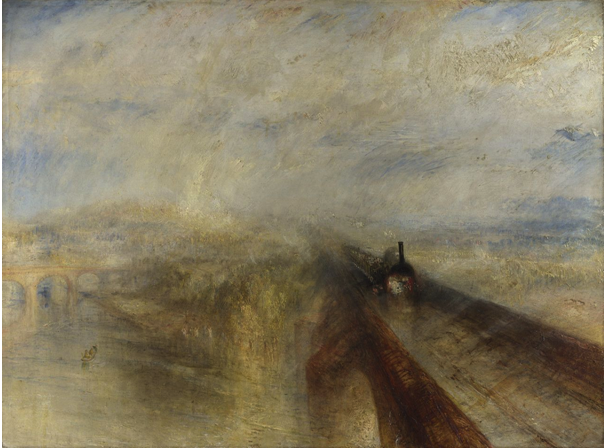J. M. W. Turner, "Rain, Steam and Speed—The Great Western Railway" (1844) National Gallery, London
John Berger, "J. M. W. Turner," Portraits: John Berger on Artists (London and New York: Verso, 2015 ) Kobo edition
A short analysis of Turner's painting inspired by John Berger's insightful essay on Turner in his book Portraits.
"Turner transcended the principle of traditional landscape: the principle that a landscape is something that unfolds before us," John Berger tell us in Portraits.
Instead, Turner landscapes appear to "extend beyond [their] formal edges," working their way around the spectator "in an effort to outflank and surround him." (22)
"Rain, Steam and Speed—The Great Western Railway" does not lend itself to easy description. It certainly didn't at the time when it was first exhibited. Neither the scene depicted nor the technique employed would have been easy to grasp or describe, even by an expert reviewer. "The world has never seen anything like this picture," the Victorian novelist W. M. Thackeray famously remarked. This is because, Berger tells us, Turner's vision "dismisses or precludes words." (3)
In his essay, Berger points out a possible connection between the English painter's experiences as a child in his father's barber's shop and his imaginative vision, but reminds us that "they should be noticed in passing without being used as a comprehensive explanation." (5) We should not reduce Turner's style to a series of images, like "water, froth, steam, gleaming metal," or the "soapy liquid agitated by the barber's brush," or the "detritus deposited" on the water's surface (5). But as soon as one envisions the "soapy" froth floating on his father's barber's bowl, certain aspects of Turner's painting style become clearer, or perhaps more manageable. New images, other analogies begin to take shape. For me, "soapy froth" conveys perfectly the mess of paint I see forming at the centre of the canvas. Berger knows that a simple image can trigger a cascade of associations; his caveat to the reader not to read too much into the images he is suggesting is more like a signal to stop and consider the connection more closely--don't read too much into them; let them do their work in your imagination. A Turner landscape may dismiss language's explanatory power, but it certainly offers other ways to engage with it. And Berger knows.
Turner's vision "precludes words." There is nothing else we can do but to submit to the experience of being absorbed inside his space. Who hasn't felt, at least once, the irrepressible urge to step inside a painting and become part of its world? When I look at a Constable landscape, I feel comfortable remaining outside, as a viewer. When I look at a Turner landscape, I feel drawn into the scene, but I try to resist its pull, because I know I am being drawn into another place, one I'm not completely comfortable in, a "violent" place, like the scene of a crime. Berger notes that what is "so disturbing" about many of Turner's lanscapes is "the global indifference that they record," (18) but it is also this indifference that, in the last instance, "allows them to be seen as beautiful."(18) Turner's "violent" landscapes "preclude" the "outsider spectator, "(22) Berger adds, meaning that they do not allow the viewer to remain indifferent to their presence. I resist the magnetic force of the landscape unfolding before and around me, but I cannot deny its beauty, or its power. I am "surrounded" and "outflanked" by the elemental forces unleashed in the painting, by the speed and force of industrialization, by the approaching train; by the colours, the shadows, the globs of paint; I am absorbed by "The Maelstrom" (the title of another of Turner's landscapes).
Turner's paintings "preclude" words; they preclude an "outsider spectator." One has no choice but to be involved in a Turner landscape, to be a "spectator" looking at the scene from within. This is what John Berger believes. And that is what I believe, too.
For a full analysis of the painting, see Inigo Thomas's essay in the London Review of Books
Khan Academy has a short video on this painting, as well as other paintings by Turner and his contemporaries.
John Ruskin's Modern Painters is available at the Internet Archive

 RSS Feed
RSS Feed
